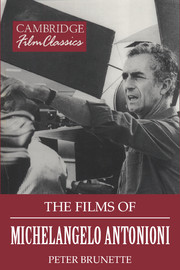5 - Blow-up (1966)
Published online by Cambridge University Press: 05 June 2012
Summary
It is difficult to say anything new about Antonioni's next film, Blow-up, made in 1966. Literary critics, philosophers, anthropologists, and a host of others, slumming from time to time in the movies, seem invariably to have felt the need to talk about this particular film. One reason is that it was an international art-house success, even beyond that of the trilogy (in no small part because of its steamy – for the time – sex and drug scenes), with a relatively well-known cast that had wider drawing power than less familiar Italian actors. Even more important, the film was made in English and placed in a more easily recognizable setting, and, for those reasons, it seems to be more immediately accessible than his earlier films. Above all, the film seems to have been tempting to commentators precisely because its meanings end up being so ambiguous and apparently multiple; in fact, the variety of interpretations inspired by this film is nothing short of astonishing.
By the time Blow-up appears, it has become clear that Antonioni prefers to put meanings in play, rather than to follow a prearranged, clearly worked-out plan – as he himself has always insisted in interviews – and it is this factor, more than any other, that accounts for the wide disparity in critical interpretations. (This free play also strongly marks the rather tenuous relation between the film and the short story by Argentinian writer Julio Cortàzar, “Las babas del diablo” [The devil's drool] on which it is ostensibly based.)
- Type
- Chapter
- Information
- The Films of Michelangelo Antonioni , pp. 109 - 126Publisher: Cambridge University PressPrint publication year: 1998

